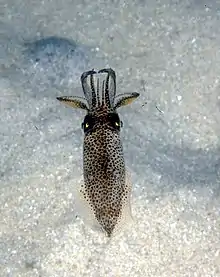Uroteuthis
Uroteuthis is a genus of 14 species of common inshore squids of the Indo-West Pacific and is further subdivided into 3 subgenera. The members of the genus Uroteuthis are the only squids of the family Loliginidae that possess photophores (light-emitting organs) and all species in the genus have a pair of photophore organs on the ventral surface of their ink sac either side of their intestine.
| Uroteuthis | |
|---|---|
 | |
| Uroteuthis noctiluca | |
| Scientific classification | |
| Kingdom: | Animalia |
| Phylum: | Mollusca |
| Class: | Cephalopoda |
| Order: | Myopsida |
| Family: | Loliginidae |
| Genus: | Uroteuthis Rehder, 1945[1] |
| Type species | |
| Uroteuthis bartschi Rehder, 1945 | |
| Species | |
|
See text | |
Uroteuthis species range in size between 3 cm to 100 cm (mantle length). As with all other members of the family Loliginidae, they have a cornea that covers the lens of each eye, and have a gladius that extends the full length of the mantle and a gill that has a branchial canal.
The type species for the genus is Uroteuthis bartschi described by Rehder in 1945.[2][3]
Distribution and Range
The members of the genus Uroteuthis are neritic squids (i.e., they occupy waters over the continental shelves) leading to the common name inshore squid being used for many Uroteuthis species. They are disturbed widely throughout the Indian Ocean and the Western Pacific, as well as the Red Sea and the Persian Gulf. The species within the genus are commercially important targets for large scale and artisanal fisheries.
Subdivisions
The genus Uroteuthis is subdivided into three subgenera, two of which are represented by a single species each. The designation of two species (U. pickfordi and U. reesi) to subgenera has yet to be accepted.
Following convention, where a species has been re-designated to the genus Uroteuthis from a different genus, the originating authority has been included in brackets. Common names have been included where they are known and are unique to a species.
- Subgenus Uroteuthis
- Uroteuthis bartschi Rehder, 1945:[2] Bartsch's squid
- subgenus Aesturariolus
- Uroteuthis (Aesturariolus) noctiluca (Lu, Roper and Tait, 1985):[4] luminous bay squid
- Subgenus Photololigo Natsukari, 1984[5]
- Uroteuthis abulati (Adam, 1955)[3][6]
- Uroteuthis arabica (Ehrenberg, 1831)[7]
- Uroteuthis bengalensis (Jothinayagam, 1987)[8]
- Uroteuthis chinensis (Gray, 1849):[9] mitre squid
- Uroteuthis duvauceli (Orbigny, 1835):[3] Indian Ocean squid
- Uroteuthis edulis (Hoyle, 1885):[10] swordtip squid
- Uroteuthis robsoni (Alexeyyev, 1992)[11]
- Uroteuthis sibogae (Adam, 1954):[12] Siboga squid
- Uroteuthis singhalensis (Ortmann, 1891):[13] long barrel squid
- Uroteuthis vossi (Nesis, 1982)[14]
- Subgenus incertae sedis (i.e. uncertain)
References
- Julian Finn (2016). "Uroteuthis Rehder, 1945". World Register of Marine Species. Flanders Marine Institute. Retrieved 24 February 2018.
- Rehder, HA (1945) A new genus and species of squids from the Philippines, Proceedings of the Biological Society of Washington, 58
- Vecchione, M., T. F. Brakoniecki, Y. Natsukari and R. T. Hanlon. 1998. A Provisional Generic Classification of the Family Loliginidae. Smithson. Contributions Zool., 586
- Lu, CC, Clyde FE Roper, and RW Tait (1985) A revision of Loliolus (Cephalopoda: Loliginidae), including L. noctiluca, a new species of squid from Australian waters, Proceedings of the Royal Society of Victoria , 97 (2)
- Bouchet, P. (2015). Photololigo Natsukari, 1984. In: MolluscaBase (2015). Accessed through: World Register of Marine Species at http://www.marinespecies.org/aphia.php?p=taxdetails&id=562500
- Adam, W. (1955) Cephalopodes. Résultats Scientifiques des Campagnes de la "Calpso," I. Campagne 1951-1952 en Mer Rouge, Annales de l'Institut Oceanographique, 30 (In French)
- Ehrenberg, CG (1831) Animalia invertebrate exclusis insects, Symbolae Physicae, seu Icones et descriptiones corporum Nauralium novorum aut minus cognitorum .. PC Hemprich et CG Ehrenberg .. Pars Zoologica. Vol. 4 (In Latin)
- Jothinayagam, JT (1987), Cephalopoda of the Madras coast, Zoological Survey of India, Technical Monograph, 15
- Gray, J. E. 1849. Catalogue of the Mollusca in the British Museum. Part I. Cephalopoda Antepedia. 164
- Hoyle, W. E. 1885. Diagnosis of new species of Cephalopoda collected during the cruise of H.M.S. "Challenger" - II. The Decapoda. Annals and Magazine of Natural History, (series 5) 16. 181-203
- Alexeyev, D. O. 1992. The systematic position of bioluminescent squids of the family Loliginidae (Cephalopoda, Myopsida). Zoologichesky Zhurnal, 71 (11). 12-23
- Adam, W. (1954) Siboga - Expeditie. Cephalopoda Part III. IV Cephalopodes a l'exclusion des genres Sepia, Sepiella et Sepioteuthis, Results des explorations zoologiques, botaniques, oceanographiques et geologiques entreprises aux Indes Orientales Neerlandaises a 1899–1900, 55c (In French)
- Ortmann, A. 1891. Cephalopoden von Ceylon, gesammelt von den Herren Dres. Sarasin. Zoologische Jahrbucher, (Systematik), 5. 669-678 (In German)
- Nesis, KN (1982) Abridged Key to the Cephalopod Molluscs of the world's oceans
- Voss, GL (1962) Six new species and two new subspecies of Cephalopods from the Philippine Islands, Proceedings of the Biological Society of Washington, 75
External links
 Media related to Uroteuthis at Wikimedia Commons
Media related to Uroteuthis at Wikimedia Commons